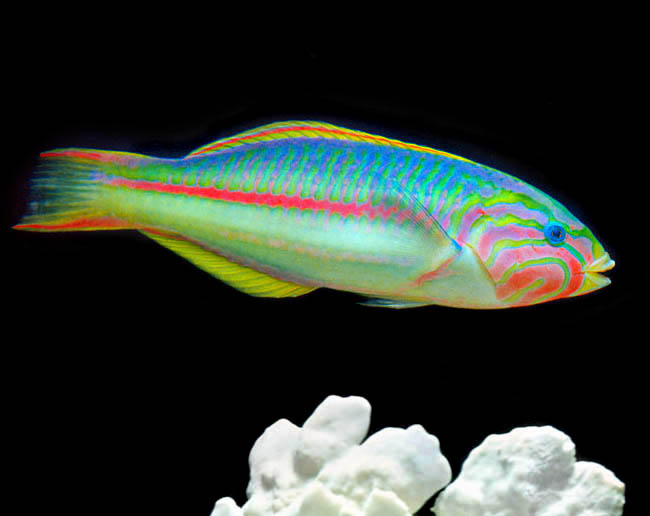Family : Labridae

Text © Giuseppe Mazza

English translation by Mario Beltramini
The colorful and showy Klunzinger’s Wrasse (Thalassoma rueppellii – Klunzinger, 1871) belongs to the class of Actinopterygii, the ray-finned fishes, to the order of Perciformes and to the great family of Labridae, rich of more than 500 species.
The name of the genus comes from the Greek “thalassa” = sea and “soma” = body; so it is matter of a fish having the colour of the sea.
The name of the species honours the memory of Eduard Rüppell (1794-1884), son of a rich German banker. Fascinated by the Natural History, after an exciting journey in Sinai, he studied botany and zoology at the Universities of Pavia and Genoa making various and fruitful scientific explorations. He has been one of the first Europeans to reach the Gulf of Aqaba and Massawa, where this fish is very common.
Zoogeography

Thalassoma rueppellii is a protogynous hermaphrodite species endemic to Red Sea © Giuseppe Mazza
It is a species endemic to the Red Sea.
Ecology-Habitat
It lives among the corals, in relatively shallow waters, but also at around 30 m of depth on the outer side of the reefs.
Morpho-physiology
Flat and rangy, it can reach the 20 cm of length with a really unmistakeable livery.
On the pale pastel blue-green colour stands out, at the centre of the sides, a flaming horizontal line from which depart, on top, some pink vertical stripes turning violaceous.
The head is adorned by more or less blue stripes surrounding the eye, but, especially, by red bands like on the outer sides of the tail and at the centre of the long yellow dorsal.
The anal fin is yellow with pink base and the pectoral and ventral ones show blue traits. The females and the young males have less garish colours.
Even if the upper profile of the body is decidedly less bent it reminds, due to the shape of the fins and the spiny rays, the Thalassoma lunare with which often hybridizes.
Ethology-Reproductive Biology
Also this one is a protogynous hermaphrodite species, that is, with females who, when growing, can transform into males. It nourishes of benthic animals, the eggs are entrusted to the currents and adapts well to the captivity life. The decimated by the events populations can double in 1,4-4,4 years and the species has therefore nowadays a modest vulnerability index, 29 on a scale of 100.
Synonyms
Julis rueppellii Klunzinger, 1871; Thalassoma klunzingeri Fowler & Steinitz, 1956.
→ For general information about FISH please click here.
→ For general information about BONY FISH please click here
→ For general information about CARTILAGINOUS FISH please click here.
→ To appreciate the BIODIVERSITY of BONY FISH please click here.
→ To appreciate the BIODIVERSITY of CARTILAGINOUS FISH please click here.
